|
| Author |
Message |
Nobadays
Member
|
# Posted: 31 Aug 2019 19:15 - Edited by: Nobadays
Reply
Quiet around here...Labor Day weekend...everybody's at the cabin!
So started another winterizing project.... well more like a spring/fall. For winter we have decided on a 65 gallon tank in the loft plumbed with a faucet to the kitchen sink.
So as you can see in the pictures our cistern sets about 30' from the house(it is 550 gallons and has about 2" of spray foam on the outside of it). Garden hose with foam pipe insulation makes the connection to a box by the house containing a 12v deep cycle battery and a Shurflo pump. Then more garden hose from there to a connection to the house plumbing.
The plan is to build an insulated box around the outlet/fill pipe at the cistern and move the pump/battery over there... less noise in th he house. I will use 2" ISO rigid foam plus fiberglass loosely packed around the pump/pipes. Then run PEX tubing into the ground through an insulated, pressure treated wooden box. The PEX will be buried 18" with 2" of foam insulation on top of it before burial... frost line here is about 18" unless it's an open winter which is seldom.
On the other end the PEX will come up through an insulated pressure treated wooden box and make the connection to the house.
Everything is drained and blown out for winter. Just tired of the above ground hoses freezing nearly every night in the early spring and fall.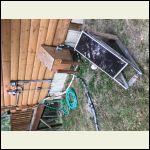
Pressure pump battery
| 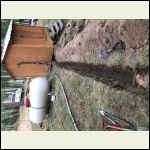
Cistern
| 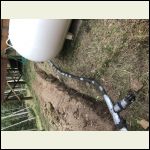
Trench dug
|  |
|
|
paulz
Member
|
# Posted: 31 Aug 2019 21:54
Reply
Nice looking trench! Hand dug? I don't know about frozen pipes where I'm at, but my Shurflo is directly under my cabin and it doesn't make much noise at all. And I kind of like knowing when it is running. Will you run wiring and a switch to the cabin?
|
|
Nobadays
Member
|
# Posted: 31 Aug 2019 23:03
Reply
Thanks... yep hand dug 20' in about 5 hours. Lots of rock! Our Shurflo really isn't too loud but moving it over to the cistern will likely eliminate all noise from the pump.
Presently the pump has it's own solar panel and 12v battery with a switch in the pump box. I will use this same set up for now. No switch in the house. I will be putting a piece of 3/4" conduit in the trench to run 14/2 wire through and will eventually use a 120vac/12vdc transformer to power the Shurflo pump. Even further down the road I will put an AC Shurflo pump in once this 12vdc and my spare give out.
I'm also planning to drop a 1 1/4" conduit in with the 3/4" (both will go on top of the ISO insulation) as I am building off the other side of the cistern shed a place to store tools and fuels, as well as a separate space to put my generator. Presently the generator is on the other side of the cabin so will have to turn the wire and run it the other way. Again, noise away from the cabin (we haven't run the generator to power the cabin, just to run power tools since installing solar back in June.) Using the larger conduit as we will be pulling 10/2 one way and 12/2 back for a couple of outdoor plugins for building projects which we use the generator for.
|
|
ICC
Member
|
# Posted: 1 Sep 2019 00:16 - Edited by: ICC
Reply
I would not use polyiso in the ground. It does absorb moisture and the r_value plummets when wet. In a wall the foil facing makes it mostly impervious to water especially when the seams are properly taped.
Better would be to use XPS foam sheet. That is the insulation that can be used under poured concrete. Code will not allow polyiso under a slab.
I have a couple cisterns buried with a layer of XPS above them and a turned down edge of sheet XPS around the perimeter. That extends down below frost level. Those cisterns don't freeze even if the ground freezes to 36", the deepest I have ever seen here.
|
|
Brettny
Member
|
# Posted: 1 Sep 2019 07:10
Reply
If your frost depth is 18in there no need for insulation or a wood box in thr trench. If your worried about it freezing you could burry it a bit deeper of wirh only 20' run a heat tape on the pipe.
Plastic pipe can take a freeze prety darn well.. the fittings how ever cant.
|
|
Nobadays
Member
|
# Posted: 1 Sep 2019 09:34
Reply
Brettny.... I wasn't convinced 18" is correct. Not sure the local who told me really knows. It regularly gets to -20 here in the winter and they have had winters where it hit -30 with day time temps never rising above freezing. If there was no snow on the ground I think the frost could go much deeper pretty quickly.
All that said, there won't be water in the line during the winter anyway as we are at the cabin from mid May until about the end of October, or when the snow runs us out. The insulation would just lay on top the PEX in the trench to help slow down the descending frost (probably not needed but we may try using it in the winter so planning ahead). The isulated wooden boxes will just surround the pipe as it comes up out of the ground into the pump house and where it makes the attachment to the cabin plumbing. All the fittings will be in the insulated boxes where the attachments are made to both the house and the pressure pump.
Solar electric... heat tape is out but good idea!
Digging deeper.... 5 hours to dig 20'... nope not going deeper
|
|
Nobadays
Member
|
# Posted: 1 Sep 2019 09:41
Reply
ICC.... Thank you for the heads up on insulation type... I will most definitely get the XPS foam!
|
|
Nobadays
Member
|
# Posted: 1 Sep 2019 12:08
Reply
Found a "typical" frost depth map for Colorado.... our area in southern CO is showing 30". That said, the valleys and plains get a lot colder and have less snow than we typically get. I just can't dig any deeper, getting to 18" was quite a challenge.
I had read somewhere that each inch of foam on top of a buried pipe adds approximately 1' to the depth. Don't know where I read that and/or how true it is (but it was on the internet so must be true!) As stated above though, most likely there will be no water in the line in the winter... but we might at sometime try it.
Really looking forward to building the inclosed lean-to off the other side of the cistern shed to house tools, fuels and my generator. Presently we have 21 gallons of fuel stored under the cabin! Not good!! It's where the PO stored it, and there are no other outbuildings on the property to get it away from the cabin.
Thanks for the help! I'll post more pictures as the project proceeds.
|
|
|
Nobadays
Member
|
# Posted: 3 Sep 2019 06:39
Reply
Work I got done yesterday... framed the enclosure for the Shurflo and battery. You can see in the picture the wooden "box" coming up out of the trench. Once the PEX is installed I will spray foam around it in that box.
The other picture is of the opposite side of the cistern shed and the extension that will house the generator and tool/fuels. Tools/fuels will be separated from the generator by a partition wall.
Off today to purchase a snowmobile for winter access... getting a 2 up utility machine, Yamaha RS Viking. Five hour drive to where the snowmobile is then another hour up to another city to pick up a cargo sled. Building projects on hold for a couple of days... but will pick up more materials and the PEX while in the big city!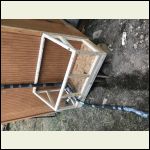
Pump house
| 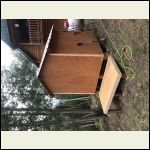
Tool fuel generator extension
|  |  |
|
|
Brettny
Member
|
# Posted: 3 Sep 2019 07:11
Reply
You can try to justify 18in any way you would like but if you get down to -20F 18in is not your frost depth. We dont nearly get that cold and ours is 48in.
On solar with heat tape...running a generator for 30min is going to be alot easier than digging up your pipe in the spring when it freezes. It also gives you the option to see that it froze, thaw it out then blow it out with compressed air.
|
|
Nobadays
Member
|
# Posted: 3 Sep 2019 07:48
Reply
Brettny... I'm sure your right but fortunately we will not likely be using this water system in the winter... might try it if we ever try to stay up here all winter... but we will drain and blow out the line every fall. For winter we are going to use a tank in the loft with a pipe/faucet to the kitchen sink.
The heat tape is a good idea for thawing the line if needed. Will look into that. The only way I have used heat tape before was having it on all the time and that just won't work with solar.
I wish I could dig it deeper but about trashed my arm getting 18".... there are disadvantages to only having one arm....especially after 30 years of use, its kinda wore out....
|
|
Brettny
Member
|
# Posted: 3 Sep 2019 12:28
Reply
If your blowing out in the fall heat tape may not be needed. It takes a while for frost to get in the ground.
|
|
NorthRick
Member
|
# Posted: 3 Sep 2019 18:16
Reply
Quoting: Nobadays I had read somewhere that each inch of foam on top of a buried pipe adds approximately 1' to the depth.
That's the rule of thumb we go with up here in Alaska. In my mind, 2" of foam board is a lot better than digging another 2 ft in rocky ground.
|
|
Nobadays
Member
|
# Posted: 4 Sep 2019 08:02
Reply
NorthRick.... perhaps you mentioned using foam over pipe before.... if it works for folks in Alaska it can't hurt here in Colorado!
|
|
Brettny
Member
|
# Posted: 4 Sep 2019 08:11
Reply
You will still need to add heat to the pipe. A pipe with no flowing water and not below the frost line will freeze no matter how much foam you add to it.
If your blowing the system out i wouldnt even bother with the foam since your almost 2ft below the ground.
|
|
ICC
Member
|
# Posted: 4 Sep 2019 16:21
Reply
Quoting: Brettny You will still need to add heat to the pipe. A pipe with no flowing water and not below the frost line will freeze no matter how much foam you add to it.
Yes, insulation only slows heat transfer from a warmer side to a colder side. However, the earth is warmer the deeper you go, so insulation can be used to trap the lower level heat. If the insulation goes down the sides of the pipe like an inverted U-shape or a tunnel that can hold heat from the lower earth. Or simply extending the horizontal layer out further to the sides, similar to a shallow frost proof foundation may work. However both need more excavation than a simple trench as shown.
|
|
Steve_S
Member
|
# Posted: 7 Sep 2019 10:07
Reply
The general rule applied here is 1" of high density foam = 1' of digging depth. To that end & leaving little to chance being in North Eastern Ontario I enclosed my underground conduits in 4" thick foam (boxed channels) with the conduits inside. The Grey Water leaves the cabin into a Filter Box (lined with 6" foam) which then runs into a 3" DWV pipe which is also encapsulated in 4" XPS foam (being only 16" below surface). Ground heat from the dry tank and deep runs (2 runs of 50', 10' deep in drain trenches) keeps things above freezing, even in the coldest of weather.
The key to using foam is to either to have a wide area covered above (2' wide) which will provide a triangular shield. Remember ground frost will creep underneath if not deep or wide enough.
|
|
ICC
Member
|
# Posted: 7 Sep 2019 10:56
Reply
FWIW, if anyone is interested, here's an image of more or less what I did with the cistern at the hunt cabin. This image is from another site. I did not insulate around pipes going up into the cabin as my cistern pump drains back into the cistern. And mine does not have an input line from a well; water is brought in by truck a couple of times a year.
|
|
Nobadays
Member
|
# Posted: 7 Sep 2019 15:47
Reply
Thanks for all this information, good stuff! Since I plan to drain things in the winter, putting foam over the pipe was probably wasted... but I did anyway. Still working on getting the boxes insulated and will soon, hopefully transfer the Shurflo and battery over to the new pump house.
The rain keeps slowing us down... right now raining and sunshine at the same time.... yesterday, torrential downpour.
|
|
Nobadays
Member
|
# Posted: 8 Sep 2019 19:50 - Edited by: Nobadays
Reply
Pump moved and all is working well!
The box where the water ties to the house is complete, other than staining.... when the weather turns cold/freezing, the faucet will be removed and the water hole plugged with rigid foam. Pics don't show the lid... it's on now.
The pump house needs a lot more work. Another layer of rigid insulation and then all the pipes wrapped as extra insurance. Probably some fiberglass batts tucked in around things as well. Eventually I will be running 120vac out there to power a 120vac/12vdc transformer. When I do that I will put in a receptical so on cold nights a light bulb could be left on in there to provide a little heat... depending on how much "juice" the batteries have.
Headed back to our primary home in AZ for a few days, then back to the cabin to finished up projects.... hoping to put the first layer of Polyiso insulation under the floors before we get forced out by snow.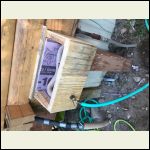
Cabin connection
| 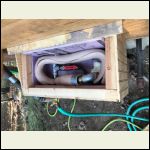
Same
| 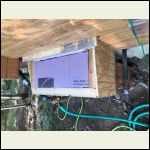
2 inches of foam on top
| 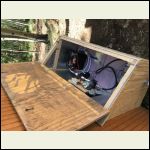
Pump house
|
|
|
Nobadays
Member
|
# Posted: 11 Oct 2019 09:36
Reply
Well.... 14*F this morning and the water is running! Without heat in the pump house I doubt the insulation alone would keep it from freezing if the temps didn't warm during the day. For fall and spring cold weather use I think we will be ok.
Just glad it works.... last spring, with the waterlines on the surface, if it hit even the upper 20's our water was frozen until mid day.
|
|
|

